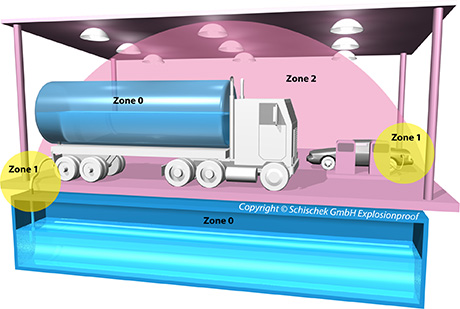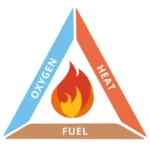
Blog
Definitions of Hazardous Area Classifications

EXPLOSIVE ATMOSPHERE
A mixture of flammable substances in the form of gases, vapors, dusts, fibers, or flyings with air under atmospheric conditions, which, after ignition, allows the propagation of a flame throughout the unburned mixture.
HAZARDOUS AREA
An area in which an explosive gas atmosphere is expected or may be expected to be present in such quantities that special precautions are required in the construction, installation, and use of equipment.
NON-HAZARDOUS AREA
An area not located within or around any flammable material.
NEGLIGIBLE AREA
An area where an explosive gas atmosphere is not present in sufficient quantities to require special precautions in the construction, installation, and use of equipment, or where the risk of explosion (e.g., flash fire) is considered negligible.
EXPLOSION
Explosion is essentially a special form of combustion. It is the destructive effect that occurs when the pressure created by rapidly expanding gases, resulting from extremely fast combustion, exceeds the strength of the confined space in which they are contained.
Presence of Flammable Substances (Gas)
According to EN 80079-20-1, Flammable Liquid Vapors:
-
H220-H222-H224 – Category 1
-
H225 – Category 2
-
H223-H226 – Category 3

| Classification | Definition | ATEX Zone Equivalent | Examples |
|---|---|---|---|
| Explosive Atmosphere | A mixture of flammable gases, vapors, dusts, fibers, or flyings with air under atmospheric conditions that, after ignition, allows flame propagation. | General definition (applies to all zones) | Oil & gas plants, chemical factories, grain silos |
| Hazardous Area | An area where an explosive gas atmosphere is expected or may be expected in such quantities that special precautions are required in construction, installation, and use of equipment. | Zone 0 / Zone 1 / Zone 2 (gases, vapors) · Zone 20 / Zone 21 / Zone 22 (dusts) | Refineries, mines, paint shops, food processing plants |
| Non-Hazardous Area | An area not located within or around any flammable materials. | Outside ATEX zoning | Offices, segregated control rooms |
| Negligible Area | An area where an explosive atmosphere is not present in sufficient quantity to require special precautions, or where explosion risk (e.g., flash fire) is negligible. | Outside ATEX zoning | Well-ventilated or isolated sections |
| Explosion | A rapid combustion event where expanding gases create a pressure that exceeds enclosure strength, causing destructive effects. | Applicable to all zones when ignition occurs | Any confined hazardous enclosure |
Remember: Select equipment with certification appropriate to the designated zone (e.g., Zone 1 vs. Zone 2; Zone 21 vs. Zone 22).
| Category | Hazard Statements (H-codes) | Typical ATEX Zones | Description |
|---|---|---|---|
| Category 1 | H220, H222, H224 | Zone 0 / Zone 20 (continuous presence) | Extremely flammable gases and vapors; explosive atmosphere present continuously or for long periods. |
| Category 2 | H225 | Zone 1 / Zone 21 (likely to occur) | Highly flammable liquids and vapors; explosive atmosphere likely to occur in normal operation. |
| Category 3 | H223, H226 | Zone 2 / Zone 22 (abnormal conditions) | Flammable liquids and vapors; explosive atmosphere unlikely in normal operation and if it occurs, will exist only for a short time. |












